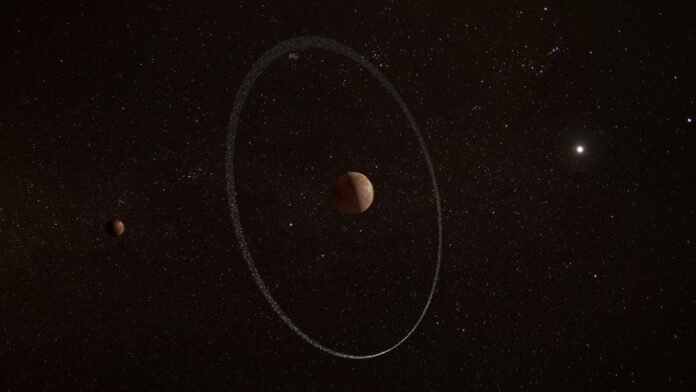The James Webb Space Telescope (JWST) can tell us a lot about the subjects of its observations if it spends enough time with them. That includes lonely rocks on the edges of our solar system, such as the Trans-Neptunian Object (TNO) Quaoar. Recent observations using the NIRCam on JWST and pre-published on arXiv by researchers at the University of Central Florida, the Space Telescope Science Institute, and Kyoto University add a plethora of new data to our understanding of this enigmatic object, including insights into what might be causing its ring system and its hydrocarbon atmosphere.
Quaoar is an interesting object in its own right. At 41 AU away from the Sun, it is squarely past the orbit of Neptune, officially making the ball of rock a TNO. It is estimated to be about 1110 in diameter, though it is “squashed” meaning its poles are much flatter than would be expected for a perfect sphere, with its height coming in at only around 560 km. However, there are two physical aspects of Quaoar that are particularly interesting to scientists – its rings and its hydrocarbon “atmosphere”.
Scientists have known that Quaoar has two ring systems, named Q1R (outer) and Q2R (inner) respectively. However, they are strange in that they seemingly violate the Roche limit, a mathematical distance from an object where any Moon that would form would be ripped apart into a ring instead of coalescing into a moon. Both of Quaoar’s rings lie outside the dwarf planet’s Roche limit, calling into question the process that created them.
Another strange fact of Quaoar is that it is thought to have a hydrocarbon atmosphere, primarily made up of methane. Previous observations had suggested that its might have been relatively thick, but follow up observations had called that into question – the JWST team hoped to put the debate to rest.
The team used Quaoar’s occultation of a background star to monitor its rings, its atmosphere, and even tried to constrain its shape. In doing so, they collected a series of data that, while confirming some parts of the physical structure of Quaoar, called others into question.
Data about the dwarf planet’s rings were particularly interesting. Previous studies had found variations in the Q1R ring that showed up as fluctuations on either side of Quaoar. JWST’s data showed symmetric rings, though there were some patterns that hinted at potential internal structure, but not with enough certainty to definitively say they took any particular pattern or shape.
Video describing Quaoar with a song. Credit – KLT YouTube Channel
Q2R, on the other hand, was only seen on the “egress” side of the planet, showing that it has extreme variability depending on which side of the dwarf planet is observed. Additionally, JWST was able to provide updated radius calculations for each ring – Q1R is estimated at about 4096 km while Q2R is estimated at about 2529 km. The telescope also found a lower limit on the size of the particles that make up the ring – estimating that they were at least 3-4 micrometers in size, as smaller particles would have blocked less of the longer wavelength light the sensor was monitoring.
The differences between previous observations and the new ones could be explained by some interesting phenomena. Q2R being lopsided could result from a third, as yet unimaged ring, that could be located slightly inside the existing Q2R ring. Alternatively, Q2R itself could be inclined in a way the researchers didn’t account for when calculating its presence. However, the most likely answer is that there was a statistical outlier in the data rather than a physical property causing the difference.
Placement of the rings, especially when it comes to orbital resonances, seems to be the defining feature of why they haven’t yet accreted into a moonlet. Q1R, the larger of the two ring systems, is influenced by both a mean motion resonance with Quaoar’s already existing moon, Weywot, and a spin-orbit resonance with Quaoar itself. The authors believe a combination of these two resonance forces might be disrupting the formation of the ring into another moon.
Discussion of Quaoar’s rings, and why they shouldn’t exist. Credit – Launch Pad Astronomy YouTube Channel
Q2R, on the other hand, is harder to explain. It is also near a spin-orbit resonance with Quaoar, but the authors think the most likely explanation for why it hasn’t formed into another moon is the presence of one or more “shepard” moons that have not yet been detected. Further studies could look into that possibility.
Quaoar’s atmosphere was another focal point of the study, but JWST failed to find any significant one. Even the lack of an atmosphere is actually an important finding as well, since it eliminates the possibility of seasonal variations causing the atmosphere to be replenished. More likely, the methane that previous studies had found was created by cryovolcanism or even impacts with other TNOs. Both of those solutions also fit nicely with potential replenishment sources for the ring systems, similar to how Enceladus’ cryo-volanism contributes to one of Saturn’s rings.
As with so many TNOs, there is much more to understand about Quaoar, but JWST has a lot of other things it needs to explore and only so much observational time to do it. For now, this data is likely the best we will collect on Quaoar for some time, though in the future we will undoubtedly get more, and this paper will likely be a seminal reference for any future studies of the enigmatic dwarf planet.
Learn More:
B. Proudfoot – Constraints on Quaoar’s rings and atmosphere from JWST/NIRCam observations of a stellar occultation
UT – The Dwarf Planet Quaoar
UT – Dwarf Planet Quaoar has a Ring
UT – JWST Observes the Kuiper Belt: Sedna, Gonggong, and Quaoar


